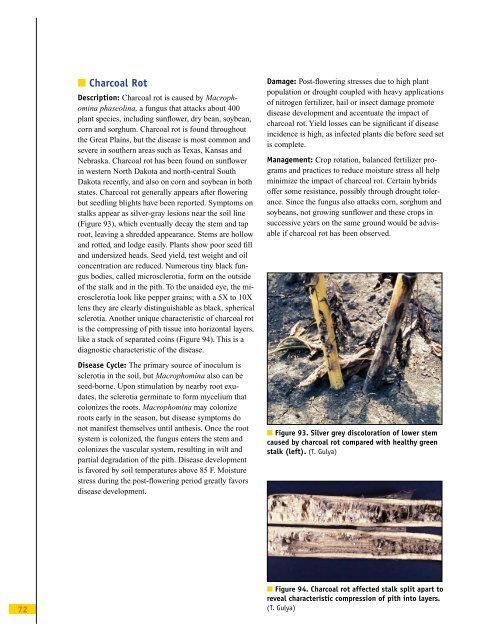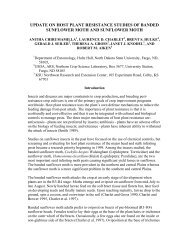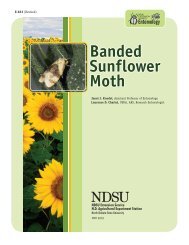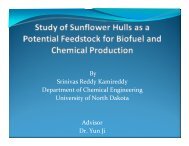■ Charcoal RotDescription: Charcoal rot is caused by Macrophominaphaseolina, a fungus that attacks about 400plant species, including sunflower, dry bean, soybean,corn and sorghum. Charcoal rot is found throughoutthe Great Plains, but the disease is most common andsevere in southern areas such as Texas, Kansas andNebraska. Charcoal rot has been found on sunflowerin western <strong>North</strong> <strong>Dakota</strong> and north-central South<strong>Dakota</strong> recently, and also on corn and soybean in bothstates. Charcoal rot generally appears after floweringbut seedling blights have been reported. Symptoms onstalks appear as silver-gray lesions near the soil line(Figure 93), which eventually decay the stem and taproot, leaving a shredded appearance. Stems are hollowand rotted, and lodge easily. Plants show poor seed filland undersized heads. Seed yield, test weight and oilconcentration are reduced. Numerous tiny black fungusbodies, called microsclerotia, form on the outsideof the stalk and in the pith. To the unaided eye, the microsclerotialook like pepper grains; with a 5X to 10Xlens they are clearly distinguishable as black, sphericalsclerotia. Another unique characteristic of charcoal rotis the compressing of pith tissue into horizontal layers,like a stack of separated coins (Figure 94). This is adiagnostic characteristic of the disease.Disease Cycle: The primary source of inoculum issclerotia in the soil, but Macrophomina also can beseed-borne. Upon stimulation by nearby root exudates,the sclerotia germinate to form mycelium thatcolonizes the roots. Macrophomina may colonizeroots early in the season, but disease symptoms donot manifest themselves until anthesis. Once the rootsystem is colonized, the fungus enters the stem andcolonizes the vascular system, resulting in wilt andpartial degradation of the pith. Disease developmentis favored by soil temperatures above 85 F. Moisturestress during the post-flowering period greatly favorsdisease development.Damage: Post-flowering stresses due to high plantpopulation or drought coupled with heavy applicationsof nitrogen fertilizer, hail or insect damage promotedisease development and accentuate the impact ofcharcoal rot. Yield losses can be significant if diseaseincidence is high, as infected plants die before seed setis complete.Management: Crop rotation, balanced fertilizer programsand practices to reduce moisture stress all helpminimize the impact of charcoal rot. Certain hybridsoffer some resistance, possibly through drought tolerance.Since the fungus also attacks corn, sorghum andsoybeans, not growing sunflower and these crops insuccessive years on the same ground would be advisableif charcoal rot has been observed.■ Figure 93. Silver grey discoloration of lower stemcaused by charcoal rot compared with healthy greenstalk (left). (T. Gulya)72■ Figure 94. Charcoal rot affected stalk split apart toreveal characteristic compression of pith into layers.(T. Gulya)
Texas Root RotDescription: Texas root rot, or cotton root rot, is asoil-borne fungal disease found only in Texas, NewMexico, Arizona, southeastern California and northernMexico. The causal agent, Phymatotrichopsisomnivora (synonym: Phymatotrichum omnivorum) hasa very broad host range of more than 1,800 species ofbroadleaf herbaceous crops and weeds. On sunflower,as with most crops, the initial symptom is wilting followedquickly by death of affected plants. The diseasein Texas develops in late spring and usually occurs incircular spots in the field, which enlarge after rain orirrigation. No diagnostic symptoms appear on leavesor stems, but white mycelial strands on roots, visiblewith a 5X to 10X hand lens, are characteristic of thisfungus. Following rain or irrigation, the fungus mayproduce white mycelial mats up to 12 inches in diameterand up to ¾ inch thick on the soil surface.Disease Cycle: The Texas root rot fungus survives formany years in the soil as sclerotia. These germinate toproduce mycelial strands that can grow some distancein the soil until root contact is made. This ability alsoallows the fungus to spread from plant to plant in arow via overlapping root systems. The disease is mostsevere in moist, warm (80 F or higher at a 1-footdepth) soils that are high pH and high clay content.Sclerotia, at first white and turning tan to dark brown,are round and generally greater than 1/12 inch in diameter.Sclerotia may form in the soil away from plantroots. On roots, the sclerotia may form at irregularintervals, giving the appearance of a string of beads.Damage: Like other root-infecting, stalk-rotting fungi,Phymatotrichum can cause considerable yield lossesif plants are infected near bloom. Even if seed yield isnot reduced, the fungal infection will lower oil contentand result in lower test weight. In field trials in westernTexas, disease incidences up to 60 percent wereobserved, which cut yields by at least half.Management: The fungus persists in the soil for manyyears as sclerotia, which are the propagules that infectsubsequent crops. Resistance has not been observedin sunflower. The best disease management is rotationwith nonhosts, such as corn, sorghum, small grains orgrass. Planting after cotton or alfalfa, especially whereTexas root rot was observed, would be the worst-casescenario.■ Phoma Black StemDescription: Phoma black stem, caused by the soilbornefungus Phoma macdonaldii, is characterizedby large, jet black lesions on the stem, sometimesreaching 2 inches in length. In addition, the fungusproduces lesions on the leaves, on the back of the headand at the base of the stalk. The typical stem lesionsoriginate with leaf infections that progress down thepetiole to the stalk. Under favorable conditions, theleaf wilts, the petiole turns uniformly black and thestem lesions expand to form a large, shiny, black patchwith definite borders (Figure 95). Small circular fruitingbodies of the fungus are produced on the surfaceof the stem, but these are inconspicuous to the nakedeye and require a hand lens to observe.Disease Cycle: Phoma infection occurs throughout thegrowing season, although it usually is not noticed untilthe stem lesions become obvious later in the summer.The fungus overwinters in infected debris and conidiaare spread by splashing rain. Insects such as Apionand Cylindrocopturus stem weevils also can carryPhoma spores both internally and externally. Adultweevils feeding on the leaves cause leaf lesions, whilecontaminated larvae spread the fungus as they tunnelthroughout the stem. Disease transmission throughinfected seed is of minor importance.■ Figure 95. Large black lesions associated withthe point of attachment of the leaf to the stem is acharacteristic symptom of Phoma black stem.(D.E. Zimmer)Diseases73










